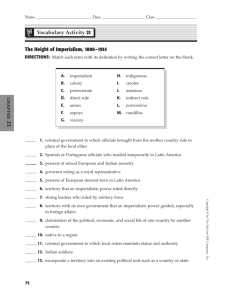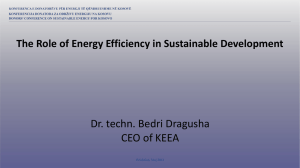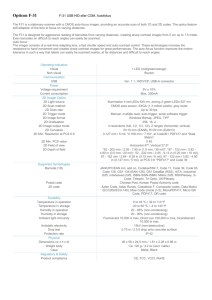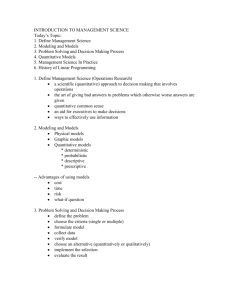1 Unit 8 (Top Ten States Categorilla)
advertisement
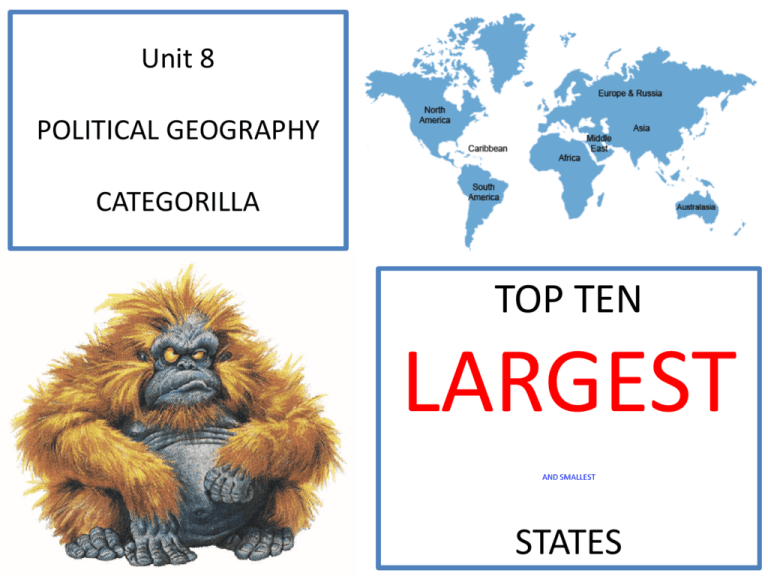
Unit 8 POLITICAL GEOGRAPHY CATEGORILLA TOP TEN LARGEST AND SMALLEST STATES GEOPOLITICS GEOPOLITICS is the study of the influence of such factors as geography, economics, and demography on the politics and especially the foreign policy of a state. This chapter will study how geography interacts with politics. Other definitions: A) those parts of geography that are dedicated to studying power, territory, sovereignty, states and governance. B) Any approach to explaining political outcomes in the world or devising political strategy by looking at or making a map. DEFINING A STATE COMPARISON NATION STATE ORIGINS OF TERM From natio (born into a place, native) From Staus Rei Publicae The Roman legal code BOUNDARIES Cultural Political, military (formal region) ORIGIN OF THE ENTITY Evolves historically from shared identity Datable, intentionally designed, legal RECOGNITION Self-identified, taught within the culture, passed by generations By other states, taught within schools/media MEMBERSHIP Kinship and shared culture Citizenship, legal CENTRIPETAL FORCES Artifacts, mentifacts, customs Legal codes, ideals LOYALTY Nationalism (1st kind) Nationalism (2nd and 3rd kinds) DEFINING A STATE COMPARISON DEFINITION NATION STATE A group of people with: An area: A common culture, a common homeland occupying a perceived territory And are self-defined/identified With shared aspirations. Organized into a political unit, Ruled by an established government With SOVEREIGNTY Occupying a defined territory Containing a permanent population. The terms STATE and COUNTRY are synonyms States have defined Boundaries (a line marking the extent of a state’s territory) Most states are divided into civil divisions (legally defined subdivisions of a state) NATION STATES & STATELESS NATIONS NATION STATE STATELESS NATION A state whose borders largely match the area occupied by a given nation (ethnic group), which was established as a state for that nation, and in which that nation is the clear majority. A nation who currently has no state in which to exercise its sovereign authority. (Remember that a nation is a people that considers itself distinct from others with a history autonomy.) COUNTING STATES Oddly enough, it’s hard to say how many states exist. THE NUMBER CHANGES OVER TIME Since about 1900, the number of states has increased over 100 with the fall of empires and the rise of nation states. The UN reports that it has 193 member states worldwide NOT EVERYONE AGREES ON WHO’S A STATE CGP Grey’s “How Many Countires are There?” Coca Cola says it sells products in over 200 states worldwide Korea reports that it exports its goods to 244 states worldwide PROBLEM STATES THE KOREAS CHINA AND TAIWAN WESTERN SAHARA The entire peninsula was a colony of Japan (sorry Henry) In the 1940s, Nationalists and Communists fought to control China. Most African countries recognize Western Sahara as a sovereign state After WWII, US and the USSR split it into two occupation zones along 38° N Lat. and later established separate Govs In 1949, the Nat’s fled to Taiwan and declared themselves the Republic of China (and mainland China’s official government) Morocco claims the territory as its own and has built a wall around it to prove it Despite the Korean War and the DMZ along the 38th parallel, both governments are commited to reunification The Communists declared the mainland the People’s Republic of China and themselves as China and Taiwan’s official government Spain controlled the area until 1976 when it withdrew and the Polisario Front declared it as the independent Sahrawi Republic MORE MURKINESS: COLONIALISM AND IMPERIALISM COLONIALISM: an existing state seizes uninhabited or sparsely inhabited land and attempts to impose political, economic and cultural control there. Europe’s colonial motives were GOD, GOLD AND GLORY Colonialism mostly refers to Europe’s activities in the Americas IMPERIALISM: an existing state attempts to impose political and economic (often cultural) control over a territory already occupied and organized by an indigenous society Imperialism refers to Europe’s activities in Africa and Asia Europe’s colonial/imperial activities began in the 1400s and then began to wane after WWII as many former colonies gained independence. New states often formed along colonial lines thus adding to the number of states. RISE OF NATIONSTATES IN EUROPE European Nation-States The map or Europe has changed drastically over that last 200 years from a few, large empires to many, smaller countries (states). As empires broke apart, the often broke into several, smaller countries/states formed as homes for various, specific ethnic groups. So the map of the world increases and decreases in number from year to year. MORE MURKINESS: COLONIALISM AND IMPERIALISM The US State Department currently lists 43 remaining colonies worldwide with indigenous populations (although the list is contested) ANYWAY… As of 2011, the UN officially recognized 193 member states. (not 192 as in the above 2005 map) 10 LARGEST STATES 1 2 2. CANADA 9.98 MIL SQ KM 9 3 3. UNITED STATES 9.82 MIL SQ KM 4 10 7 4. CHINA 9.59 MIL SQ KM 5. BRAZIL 8.51 MIL SQ KM 6. AUSTRALIA 7.74 MIL SQ KM 5 6 8 7. INDIA 3.28 MIL SQ KM 8. ARGENTINA 2.78 MIL SQ KM 9. KAZAKHSTAN 2.72 MIL SQ KM 10. ALGERIA 2.38 MIL SQ KM 1. RUSSIA 17.09 MIL SQ KM 10 smallest states (microstates) 2. MONACO 2 MIL SQ KM 2 1 9 3. CORAL SEA ISLANDS 3 SQ KM 7 4. ASHLEY & CARTIER 5 SQ KM 6 8 5 5. SPRATLY ISLANDS 5 SQ KM 3 6. NAVASSA ISLAND 5 SQ KM 7. CLIPPERTON ISLAND 6 SQ KM 8. WAKE ISLAND 7 SQ KM 9. GIBRALTAR 7 SQ KM 10. TOKELAU 12 SQ KM 10 4 1. VATICAN CITY <1 SQ KM
